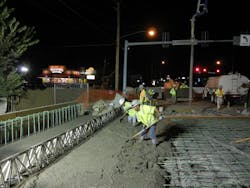Quick rebuild of the Page Avenue Bridge in St. Louis
The Page Avenue Bridge over the River Des Peres in St. Louis was worn and deteriorated after years of use. Around 60 years old, the bridge needed a new deck and replacement of the substructure above the walls. The bridge was part of the Missouri Safe and Sound Bridge Improvement Program which involved repairing or replacing around 550 bridges.
Missouri Department of Transportation (MoDOT), the owner of the bridge, hired joint venture KTU Constructors to work on the repairs. Concrete Strategies was hired by KTU to work on the replacement of the deteriorated concrete.
Since the bridge was still in use, it was necessary to make the repairs quickly, so the traffic flow would be minimally disrupted. The bridge deck had to be at 4,000 psi before it could open to traffic. To quickly achieve such a high psi, Concrete Strategies recommended replacing some of the portland cement with CTS Cement’s Komponent, an ASTM C845 cement for producing non-shrink grout and shrinkage-compensating concrete. When incorporated into a concrete mix design, the cement can reduce or eliminate shrinkage cracking in concrete, and reduce the number of joints in the concrete. Typically, about 15% of the cement is replaced with Komponent to meet the requirements of ASTM C845 Type-K cement.
On this project, MoDOT had a minimum 7-day wet cure and a 14-day cure time, with incentives for early completion. Concrete Strategies wanted a faster cure time, so they designed a new mix with Komponent and presented samples to MoDOT. The samples produced a 3-day wet cure and a 4-day total cure. MoDOT came back several times later to observe the samples for cracking, but the samples held up. The mix was approved for use.
“This is the first time in history that Type K has been used on a MoDOT bridge,” said David Murray, project manager for Concrete Strategies.
Additionally, CTS Cement’s Rapid Set was used in the shoring design and the soil retention walls as part of the jacking and cribbing plan.
“The jacking and cribbing part of the project was significant. We had to close the lanes, excavate, pour, and then open up the lanes in 12 hours total,” said Murray.
